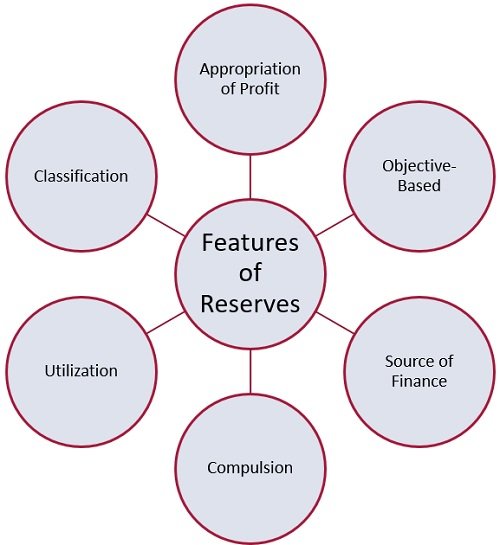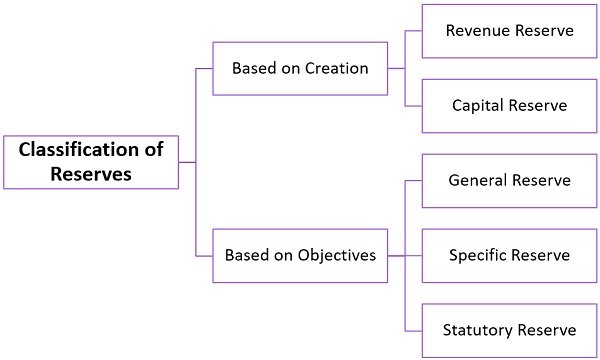Definition: Reserve, as the name suggests is a part of undistributed profit retained in the business so as to provide for specific future needs like growth and expansion, or to meet any known or unknown expenditure or contingency, liability, or reduce the value of the asset. This means that profit is kept in the business and not distributed otherwise, which helps in future expansion activities.
It is an appropriation of profit that strengthens the company’s financial position. Therefore, it decreases the amount of profit that is available for distribution, among the company’s shareholders. It appears on the liabilities side of the Balance Sheet, under the head Reserves and Surplus.
Salient Features of Reserves
Reserves are that portion of the profit that is earmarked for a specific purpose. The salient features of Reserves are:
- Appropriation of Profit: Reserves constitute the earned income of the firm. Hence, reserves can be created only when the firm has earned profits. Therefore, in the financial year in which the firm has suffered losses, the reserves are not created.
- Objective-Based: The creation of reserves is for unknown liability and not for known liability.
- Source of Finance: Reserves are among one the internal sources of finance. Hence, it can be used as capital instead of distributing as a dividend to the shareholders.
- Compulsion: The creation of reserves is not required by the statute. Nevertheless, as per Transfer of Reserve Rules, companies are required to create a certain amount of reserves out of profit, prior to the distribution of dividends.
- Utilization: Utilization of reserves are restricted to specific areas only, which are prescribed under various sections of the Companies Act, and also in the Accounting Standards.
- Classification: The classification of reserves is based on the purpose, for which the reserves are created. However, they are also created even when the purpose for their creation is not known
Classification of Reserves
The reserves are classified into two categories based on the creation and based on the objective:
Based on Creation there are two types of reserves:
Revenue Reserve
Revenue Reserves are the reserves that are created out of profit earned by the firm during the day-to-day business operations. Profit withheld from paying dividends out of the total distributable profit is called Revenue Reserve
Examples of Revenue Reserve
- General Reserve
- Debenture Redemption Reserve
- Retained Earnings
- Dividend Equalization Reserve
Capital Reserve
The reserves which are created out of the capital profit generated from the following:
- Sale of fixed assets
- Settlement of liabilities
- Premium on issue of shares
- Pre-incorporation profit
Such reserves are called capital reserves. It is a device for conserving profits and adds stability to the company’s finance. It does not include any free balance that can be used for the purpose of distribution of profit.
Examples of Capital Reserve
- Issue of shares at a premium
- Profit accruing on sale of fixed assets.
- Profit prior to incorporation
- Profit on redemption of debenture
- Premium on issue of shares and debentures
- Balance of forfeited shares account
- Creation of capital redemption reserve after preference shares are redeemed.
- Profit arising from the revaluation of fixed assets after considering all restrictions.
Based on Objectives there are three types of reserves:
General Reserve
Free reserves which are not created for a specific objective and are meant to meet unforeseen future uncertainties, liabilities or commitments, are called general reserve. It is a source of internal finance. The reason for its creation is to improve the company’s financial status, to arrange funds for meeting abnormal losses, to provide means for further expansion of operations.
It means ploughing back of profits and is not binding upon the companies to maintain a general reserve. Hence, it can be created if the management thinks fit and the profits are sufficient.
Example of General Reserve
- Reserve fund
- Contingency Reserve
Specific Reserve
Specific Reserve is the one created for a definite purpose such as:
- For equalizing the rate of dividend: Dividend Equalization Reserve is created.
- For acquiring assets: Building Reserve and Machinery Reserve are created.
- For developing business: Development Reserve is created.
- For redemption of liability: Capital Redemption Reserve and Debenture Redemption Reserve is created.
- For covering the variation in the price of investments: Investment Fluctuation Reserve is created.
Statutory Reserve
The reserve which is made due to the requirement of the law of land is termed as a statutory reserve, such as capital redemption reserve, whose creation is mandatory.
What is Secret Reserve?
Reserves that are not shown in the balance sheet are termed as a secret reserve or hidden reserve. If the secret reserve is created, then it is quite obvious that the true and fair picture of the financial position is not depicted by the financial statements of the company.
Secret reserve is created to meet extraordinary losses in the future, to strengthen the company’s financial position, to show a steady trend of profit earning, to evade taxes, etc.
The firm can use the given means to create secret reserve:
- Charging of capital expenditure as revenue expenditure.
- Providing for more depreciation on fixed assets.
- Creation of excessive provision for bad and doubtful debts.
- Suppression of sales
- Indicating imaginary liabilities or overvaluation of liabilities
- Indicating contingent liabilities as real liabilities
- Undervaluation of stock in trade
- Omission of a few assets from the balance sheet.
- Inflating purchases
Accounting Treatment of Reserves
Reserves are created by debiting the profit and loss appropriation account. A profit and loss appropriation account is created along with the profit and loss account which reveals the distribution of profit among reserves, funds, and dividends. And to do so journal entry is passed wherein profit and loss appropriation account is debited and the respective fund or reserve account is credited.
A Word from Business Jargons
Reserves are accumulated profits that are meant to be used for specific purposes. It increases the working capital of the enterprise and strengthens the financial foundation.

JAYACHANDRA T says
Good